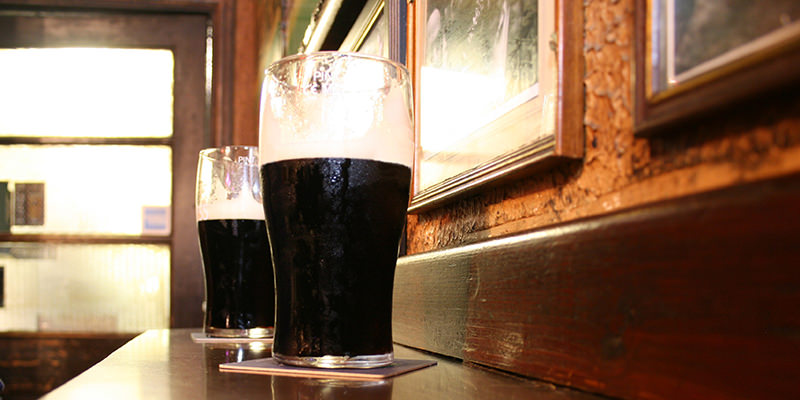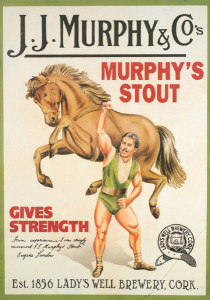The Irish Stout You Don’t Know But Should

We love Guinness. We obsess over Guinness — how to pour it, how to drink it, how to stop from drooling as we stare at those cascading nitro ripples like they’re some kind of 4.2% ABV Magic Eye. And yes, on St. Patrick’s Day, we bless ourselves with Guinness like it’s holy water at church. We suck it back like a magic potion to cure ourselves of all non-Irishness, and possibly also all sobriety.
Except Guinness isn’t the only Irish Stout our there, or even the one that every Irish man and woman swears allegiance to. And that’s because there’s Murphy’s. The Irish stout you’ve either never heard of, or heard far, far less about. (There’s also Beamish in the Big Three, but that’s for another time.)
To be fair, Murphy’s admittedly has a lot less sex appeal than Guinness. Its parent company, the Heineken corporation, tried to give it a bit of a marketing push in the 1980s and ‘90s, but that didn’t really work. So Murphy’s has remained the quieter stout beer, found in fewer pubs stateside and exalted more often in beer forums than bar-side. Whereas Guinness, founded in 1759, is by now a marketing behemoth—widget-wielding seductress of stout fans (and even non stout fans) everywhere.
So what’s the deal with Murphy’s? In a way it’s like a Burgundy compared to Bordeaux. Where Guinness has a glossy set up, complete with a “Storehouse” tasting experience in Dublin, Murphy’s is a smaller, locally adored product. In Burgundy, they drink Burgundy. In Cork, where Murphy’s is made, you simply do not order Guinness. (And outside of Cork, you simply do not find much Murphy’s.)
Some history. Again, Murphy’s is a Cork-based brewery, founded as Lady Well’s Brewery in 1856 on the site of a former foundling hospital. Don’t freak—the Murphy family didn’t kick a bunch of orphans onto the streets. In fact, James J. Murphy, who would end up running the brewery for 40 years, was a well-known philanthropist in his time, at one point even saving theentire Cork banking industry. (And not for terrible “too big to fail” reasons.) No surprise they’d end up singing songs about him in local pubs. “Hurrah for the hero!” You save my economyand supply me with beer? Yes, my friend, you’re a hero.
The stout wasn’t just beloved locally. Murphy’s Stout won gold at the Brewers and Allied Trades Exhibition in Dublin—Guinness territory—in 1892, and again in 1895. Local heroes they might have been, but the Murphy family also knew how to sell a product (per late 19thCentury standards, anyway). In his book Hidden Cork, Michael Lenihan recounts how the Murphys “commissioned Eugene Sandow, the 1891 World Weight Lifting Champion, to endorse their product,” resulting in one of the most awesome hyperbolic strongman pictures ever.

“Sandow lifting a horse became their trade mark,” says Lenihan,” with people “associating Murphy’s stout with strength.” (Guinness would essentially copy this model with an ad in The Illustrated London News Magazine in 1935.)
In fact, from then on Guinness would basically dominate the stout world. But despite some economic hiccups—a loss of interest in stout in Ireland, lowered exports into the 2000s—Murphy’s still quietly chugs along, more word-of-mouth than foam porn.
But the most important question—what does it actually taste like? Like Guinness, Murphy’s is a dry stout, and cans of it come with the same nitro widget responsible for Guinness’s overplayed cascade. It pours black, maybe darker than Guinness, with a rich roastiness (chocolate, espresso) that some—some of the lovable ranters on Beer Advocate, that is—describe as “less bitter” than Guinness. Murphy’s is also super low alcohol, 4% ABV to Guinness’s average 4.2%, meaning it’s easily sessionable, assuming your palate craves stout repetition. Considering the fact that Murphy’s is often compared to chocolate milk, repetition doesn’t seem too unappealing.
If only people knew more about it. Which, considering its (maybe involuntary) underground style, its hyper local cachet, its “like me or not, whatevs” shrugging coolness, and its (again, forced) refusal to sell out to big corporate advertising firms, they should. Yeah, in fact, Murphy’s should absolutely be the Hipster Irish Stout. If we can do any good this St. Patrick’s Day, let’s make that a thing. (Don’t worry. Guinness will be just fine.)
source: vinePair
 Блог Ireland.RU
Блог Ireland.RU
Добавить комментарий
Для отправки комментария вам необходимо авторизоваться.